Byzantine Empire › 1204: The Sack of Constantinople » Ancient origins
Articles and Definitions › Contents
- Byzantine Empire › Ancient History
- 1204: The Sack of Constantinople › Antique Origins
Ancient civilizations › Historical and archaeological sites
Byzantine Empire › Ancient History
Definition and Origins
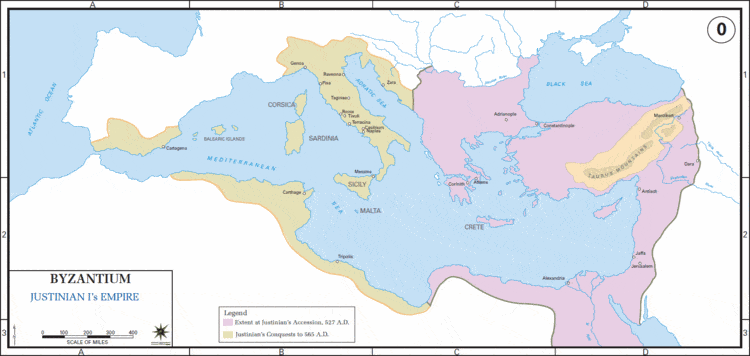
The Byzantine Empire was the continuation of the Eastern Roman Empire in the Greek -speaking, eastern part of the Mediterranean. Christian in nature, it was perennially at war with the Muslims, Flourishing during the reign of the Macedonian emperors, its demise was the consequence of attacks by Seljuk Turks, Crusaders, and Ottoman Turks.
Byzantium was the name of a small, but important town at the Bosphorus, the strait which connects the Sea of Marmara and the Aegean to the Black Sea, and separates the continents of Europe and Asia. In Greek times the town was at the frontier between the Greek and the Persian world. In the fourth century BCE, Alexander the Great made both worlds part of his Hellenistic universe, and later Byzantium became a town of growing importance within the Roman Empire.
By the third century CE, the Romans had many thousands of miles of border to defend. Growing pressure caused a crisis, especially in the Danube/Balkan area, where the Goths violated the borders. In the East, the Sasanian Persians transgressed the frontiers along the Euphrates and Tigris. The emperor Constantine the Great (reign 306-337 CE) was one of the first to realize the impossibility of managing the empire 's problems from distant Rome.
CONSTANTINOPLE
So, in 330 CE Constantine decided to make Byzantium, which he had refounded a couple of years before and named after himself, his new residence. Constantinople lay halfway between the Balkan and the Euphrates, and not too far from the immense wealth and manpower of Asia Minor, the vital part of the empire.
"Byzantium" was to become the name for the East- Roman Empire. After the death of Constantine, in an attempt to overcome the growing military and administrative problem, the Roman Empire was divided into an eastern and a western part. The western part is considered as definitely finished by the year 476 CE, when its last ruler was dethroned and a military leader, Odoacer, took power.
CHRISTIANITY
IN THE COURSE OF THE FOURTH CENTURY, THE ROMAN WORLD BECAME INCREASINGLY CHRISTIAN, & THE BYZANTINE EMPIRE WAS CERTAINLY A CHRISTIAN STATE.
In the course of the fourth century, the Roman world became increasingly Christian, and the Byzantine Empire was certainly a Christian state. It was the first empire in the world to be founded not only on worldly power, but also on the authority of the Church. Paganism, however, stayed an important source of inspiration for many people during the first centuries of the Byzantine Empire.
When Christianity became organized, the Church was led by five patriarchs, who resided in Alexandria, Jerusalem, Antioch, Constantinople, and Rome. The Council of Chalcedon (451 CE) decided that the patriarch of Constantinople was to be the second in the ecclesiastical hierarchy. Only the pope in Rome was his superior. After the Great Schism of 1054 CE the eastern (Orthodox) church separated form the western (Roman Catholic) church. The centre of influence of the orthodox churches later shifted to Moscow.
CULTURAL LIFE
Since the age of the great historian Edward Gibbon, the Byzantine Empire has a reputation of stagnation, great luxury and corruption. Most surely the emperors in Constantinople held an eastern court. That means court life was ruled by a very formal hierarchy. There were all kinds of political intrigues between factions. However, the image of a luxury-addicted, conspiring, decadent court with treacherous empresses and an inert state system is historically inaccurate. On the contrary: for its age, the Byzantine Empire was quite modern. Its tax system and administration were so efficient that the empire survived more than a thousand years.
The culture of Byzantium was rich and affluent, while science and technology also flourished. Very important for us, nowadays, was the Byzantine tradition of rhetoric and public debate. Philosophical and theological discources were important in public life, even emperors taking part in them. The debates kept knowledge and admiration for the Greek philosophical and scientific heritage alive. Byzantine intellectuals quoted their classical predecessors with great respect, even though they had not been Christians. And although it was the Byzantine emperor Justinian who closed Plato 's famous Academy of Athens in 529 CE, the Byzantines are also responsible for much of the passing on of the Greek legacy to the Muslims, who later helped Europe to explore this knowledge again and so stood at the beginning of European Renaissance.
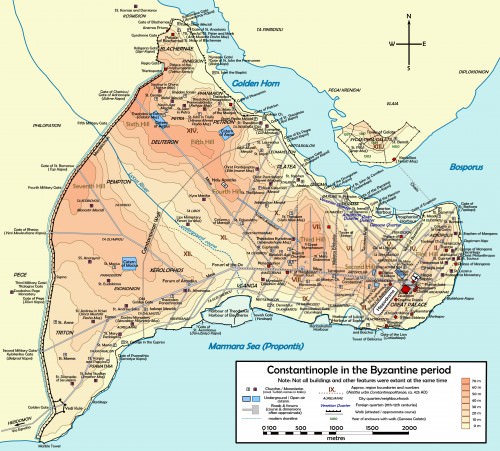
Map of Byzantine Constantinople
JUSTINIAN
Byzantine history goes from the founding of Constantinople as an imperial residence on 11 May 330 CE until Tuesday 29 May 1453 CE, when the Ottoman sultan Memhet II conquered the city. Most times the history of the Empire is divided into three periods.
The first of these, from 330 till 867 CE, saw the creation and survival of a powerful empire. During the reign of Justinian (527-565 CE), a last attempt was made to reunite the whole Roman Empire under one ruler, the one in Constantinople. This plan largely succeeded: the wealthy provinces in Italy and Africa were reconquered, Libya was rejuvenated, and money bought sufficient diplomatic influence in the realms of the Frankish rulers in Gaul and the Visigothic dynasty in Spain. The refound unity was celebrated with the construction of the church of Holy Wisdom, Hagia Sophia, in Constantinople. The price for the reunion, however, was high. Justinian had to pay off the Sasanian Persians, and had to deal with firm resistance, for instance in Italy.
Under Justinian, the lawyer Tribonian (500-547 CE) created the famous Corpus Iuris. The Code of Justinian, a compilation of all the imperial laws, was published in 529 CE; soon the Institutions (a handbook) and the Digests (fifty books of jurisprudence), were added. The project was completed with some additional laws, the Novellae. The achievement becomes even more impressive when we realize that Tribonian was temporarily relieved of his function during the Nika riots of 532 CE, which in the end weakened the position of patricians and senators in the government, and strengthened the position of the emperor and his wife.
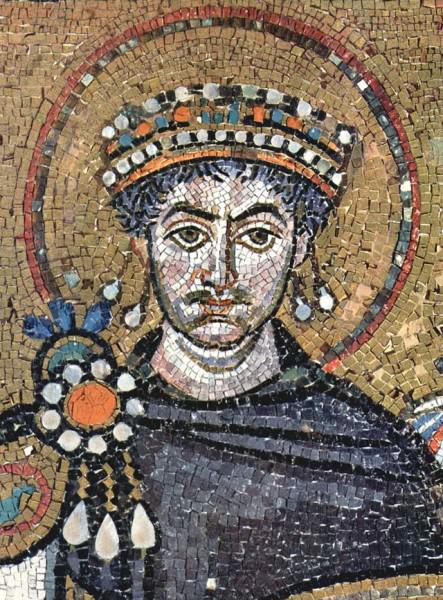
Justinian I
After Justinian, the Byzantine and Sasanian empires suffered heavy losses in a terrible war. The troops of the Persian king Khusrau II captured Antioch and Damascus, stole the True Cross from Jerusalem, occupied Alexandria, and even reached the Bosphorus. In the end, the Byzantine armies were victorious under the emperor Heraclius (reign 610-642 CE).
However, the empire was weakened and soon lost Syria, Palestine, Egypt, Cyrenaica, and Africa to the Islamic Arabs. For a moment, Syracuse on Sicily served as imperial residence. At the same time, parts of Italy were conquered by the Lombards, while Bulgars settled south of the Danube. The ultimate humiliation took place in 800 CE, when the leader of the Frankish barbarians in the West, Charlemagne, preposterously claimed that he, and not the ruler in Constantinople, was the Christian emperor.
MACEDONIAN DYNASTY
The second period in Byzantine history consists of its apogee. It fell during the Macedonian dynasty (867-1057 CE). After an age of contraction, the empire expanded again and in the end, almost every Christian city in the East was within the empire's borders. On the other hand, wealthy Egypt and large parts of Syria were forever lost, and Jerusalem was not reconquered.
In 1014 CE the mighty Bulgarian empire, which had once been a very serious threat to the Byzantine state, was finally overcome after a bloody war, and became part of the Byzantine Empire. The victorious emperor, Basil II, was surnamed Boulgaroktonos, "Slayer of Bulgars". The northern border now was finally secured and the empire flourished.
Throughout this whole period the Byzantine currency, the nomisma, was the leading currency in the Mediterranean world. It was a stable currency ever since the founding of Constantinople. Its importance shows how important Byzantium was in economics and finance.
Constantinople was the city where people of every religion and nationality lived next to one another, all in their own quarters and with their own social structures. Taxes for foreign traders were just the same as for the inhabitants. This was unique in the world of the middle ages.
CRISIS
Despite these favorable conditions, Italian cities like Venice and Amalfi, gradually gained influence and became serious competitors. Trade in the Byzantine world was no longer the monopoly of the Byzantines themselves. Fuel was added to these beginning trade conflicts when the pope and patriarch of Constantinople went separate ways in 1054 CE (the Great Schism).
Decay became inevitable after the Battle of Manzikert in 1071 CE. Here, the Byzantine army under the emperor Romanus IV Diogenes, although reinforced by Frankish mercenaries, was beaten by an army of the Seljuk Turks, commanded by Alp Arslan ("the Lion"). Romanus was probably betrayed by one of his own generals, Joseph Tarchaniotes, and by his nephew Andronicus Ducas.
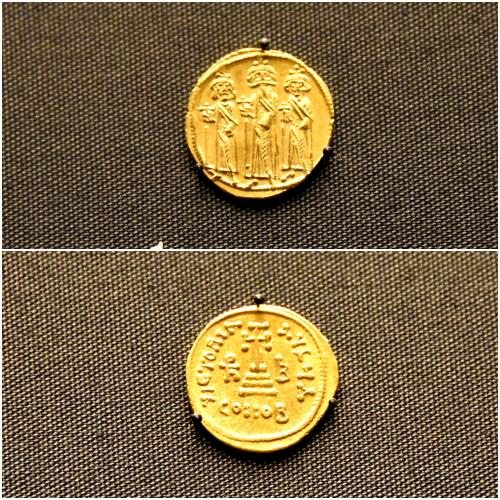
Byzantine coins of Heraclius
After the battle, the Byzantine Empire lost Antioch, Aleppo, and Manzikert, and within years, the whole of Asia Minor was overrun by Turks. From now on, the empire was to suffer from manpower shortage almost permanently. In this crisis, a new dynasty, the Comnenes, came to power. To obtain new Frankish mercenaries, emperor Alexius sent a request for help to pope Urban II, who responded by summoning the western world for the Crusades. The western warriors swore loyalty to the emperor, reconquered parts of Anatolia, but kept Antioch, Edessa, and the Holy Land for themselves.
DECLINE & FALL
For the Byzantines, it was increasingly difficult to contain the westerners. They were not only fanatic warriors, but also shrewd traders. In the twelfth century, the Byzantines created a system of diplomacy in which deals were concluded with towns like Venice that secured trade by offering favorable positions to merchants of friendly cities.
Soon, the Italians were everywhere, and they were not always willing to accept that the Byzantines had a different faith. In the age of the Crusades, the Greek Orthodox Church could become a target of violence too. So it could happen that Crusaders plundered the Constantinople in 1204 CE. Much of the loot can still be seen in the church of San Marco in Venice.
For more than half a century, the empire was ruled by monarchs from the West, but they never succeeded in gaining full control. Local rulers continued the Byzantine traditions, like the grandiloquently named "emperors" of the Anatolian mini-states surrounding Trapezus, where the Comnenes continued to rule, and Nicaea, which was ruled by the Palaiologan dynasty.
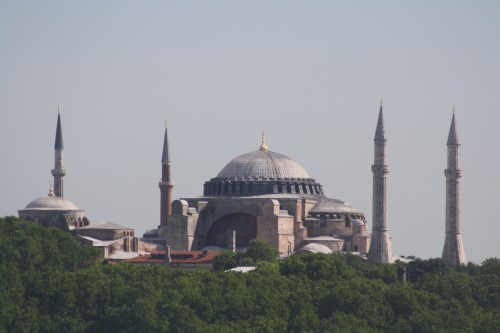
Hagia Sophia
The Seljuk Turks, who are also known as the Sultanate of Rum, benefited greatly of the division of the Byzantine Empire, and initially strengthened their positions. Their defeat, in 1243 CE, in a war against the Mongols, prevented them from adding Nicaea and Trapezus as well. Consequently, the two Byzantine mini-states managed to survive.
The Palaiologans even managed to capture Constantinople in 1261 CE, but the Byzantine Empire was now in decline. It kept losing territory, until finally the Ottoman Empire (which had replaced the Sultanate of Rum) under Mehmet II conquered Constantinople in 1453 CE and took over government. Trapezus surrendered eight years later.
ARTISTIC LEGACY
After the Ottoman take-over, many Byzantine artists and scholars fled to the West, taking with them precious manuscripts.They were not the first ones. Already in the fourteenth century, Byzantine artisans, abandoning the declining cultural life of Constantinople, had found ready employ in Italy. Their work was greatly appreciated and western artists were ready to copy their art. One of the most striking examples of Byzantine influence is to be seen in the work of the painter Giotto, one of the important Italian artists of the early Renaissance.
MAP
1204: The Sack of Constantinople › Antique Origins
Ancient Civilizations
In 1204 CE the unthinkable happened and Constantinople, after nine centuries of withstanding all comers, was brutally sacked. Even more startling was the fact that the perpetrators were not any of the traditional enemies of the Byzantine Empire : the armies of Islam, the Bulgars, Hungarians, or Serbs, but the western Christian army of the Fourth Crusade. Finally, the mutual suspicion and distrust that had existed for centuries between the western and eastern states and churches had blown up into full-scale warfare. With the fall of the city, many of its religious icons, relics, and artworks were spirited away and the Byzantine Empire was divided up between Venice and its allies. The empire would rise again from the ashes but never again could Constantinople claim to be the greatest, richest, and most artistically vibrant city in the world.
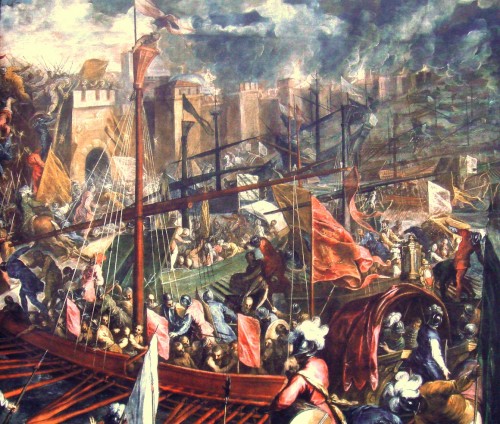
The Sack of Constantinople in 1204 CE
PROLOGUE
The Byzantines, with their capital at Constantinople founded by Roman emperor Constantine I in 324 CE, saw themselves as the defenders of Christendom, the beacon which shone out across the Mediterranean and central Asia, hosts to the holiest city outside Jerusalem, and the rock which stood against the tide of Islam sweeping in from the east. For the western half of the old Roman Empire, though, the Byzantines were regarded as decadent, shifty, and untrustworthy, their religious practices were suspect, and several of their emperors had even proclaimed icons and their veneration as heresy.
The centuries of argument and mistrust, the constant rivalry between Popes and emperors, and the rising ambition of western states to wrest from Byzantium the remnants of its empire in Italy were, for a time, held in check by the first three Crusades.All three, though, would prove to be unsuccessful in permanently securing Christianity ’s Holy Places from the Arabs. Worse, they created a damaging rift in east-west relations as blame was apportioned to either side for the lack of success. The Byzantines were considered to lack the will to fight the common enemy while, from the other side, the Crusaders were seen as opportunists out to grab the choicest parts of the Byzantine Empire in the east. In a sense, both sides were right in their judgement.
THE FOURTH CRUSADE WAS LAUNCHED BY POPE INNOCENT III IN 1202 CE WITH THE PRINCIPAL INTENTION OF RECLAIMING JERUSALEM FOR CHRISTENDOM.
The Byzantines had never fully understood the concept of a Holy War, which the western leaders used to rouse armies to be sent to the east. The west considered Byzantine emperors to be only ever interested in the preservation of their empire and perceived superiority over the west. For the emperors, though, they saw the Byzantine Empire and Christendom as one and the same thing, nor could they be criticised for thinking the Crusaders as an unruly mob of miscreants out on a looting party, given the rape and pillaging which often went on as Crusader armies passed through Byzantine territory. These were the experiences and suspicions on both sides leading into the early 13th century CE.
THE FOURTH CRUSADE
The Fourth Crusade was launched by Pope Innocent III (r. 1198-1216 CE) in 1202 CE with the principal intention of reclaiming Jerusalem for Christendom after its fall in 1187 CE to Saladin, Sultan of Egypt (r. 1169-1193 CE). In June 1202 CE the Crusaders assembled in Venice from across Europe, led by Marquis Boniface of Montferrat. From there they sailed to Egypt - seen as the soft underbelly of the enemy - or at least, that was the original plan. The Venetians, being the rapacious traders they were, insisted that their 430 ships be paid for, but the Crusaders could not meet the asking price of 84,000 silver marks.Consequently, a deal was made that in return for passage the Crusaders would stop off at Zara on the Dalmatian coast and reconquer it for the Italians, the city having recently defected to the Hungarians. The Venetians would also provide 50 ships at their own cost and receive half of any territory conquered.
The Pope was not best pleased to hear the news that Christian Zara had been sacked in November 1202 CE, and he promptly excommunicated the Crusaders and the Venetians. The ban was later lifted for the former, otherwise, they would not have been much use as Crusaders, one supposes.
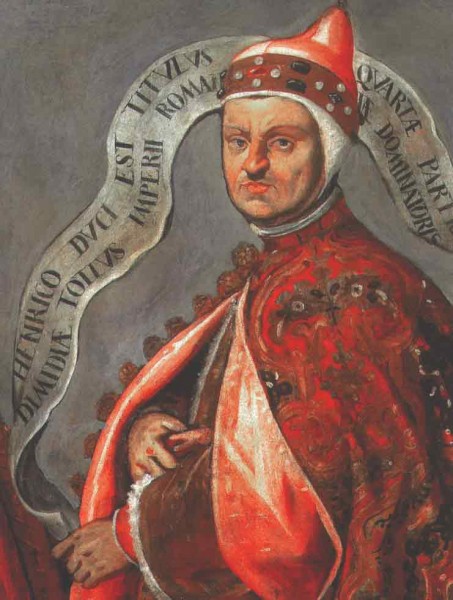
Enrico Dandolo
Historians continue to debate the exact reason why the Crusaders then turned on Constantinople instead of Jerusalem, but one crucial ingredient in the troublesome mix of mutual suspicions between the western powers and Byzantium was the Republic of Venice and one man, in particular, the Doge Enrico Dandolo (r. 1192-1205 CE). Intent on winning Venetian domination of the trade in the east, he well remembered his undignified expulsion from Constantinople when he served as an ambassador. This seemed as good an opportunity as ever to finally knock out Constantinople as a trade competitor. In addition, the Pope would achieve the supremacy of the western Church once and for all and the Crusader knights would not only gain revenge on the duplicitous Byzantines for their unhelpful support of previous Crusades but also surely pick up some glory and handsome booty in the process. The riches of Constantinople could then pay for the rest of the Crusade as it marched on to Jerusalem. It may not have been so cynically planned by all parties but, in the end, it is exactly what happened with the exception that the Fourth Crusade ended with the fall of the Byzantine capital and Jerusalem was left for a later date.
THE ATTACK ON CONSTANTINOPLE
The Crusaders arrived outside Constantinople on 24 June 1203 and played their trump card. The western powers had agreed to back Alexios IV Angelos, the son of the deposed Byzantine emperor Isaac Angelos II (r. 1185-1195 CE) and promised to return his father (then imprisoned in Constantinople) to the throne if he promised to help the Crusaders with money, soldiers, and supplies. One Crusader was especially keen on the plan - Philip of Swabia, king of Germany (r. 1198-1208 CE), whose wife Irene was the sister of Alexios IV. With such credentials as a western pawn in Byzantine politics, Isaac was duly reinstalled in the palace of his ancestors in 1203 CE with Alexios as co-emperor.
Constantinople had fallen remarkably easily once the Crusaders had overcome the garrison at Galata and lowered the massive chain which blocked the harbour of the Golden Horn. Sailing in with their fleet and attacking the sea walls and land walls simultaneously with siege engines and scaling ladders, even the elite Varangian Guard could not prevent the attackers forcing their way into the city. The incumbent emperor and brother of Isaac, Alexios III Angelos, caught completely unprepared by the arrival of the Crusaders, fled the city.
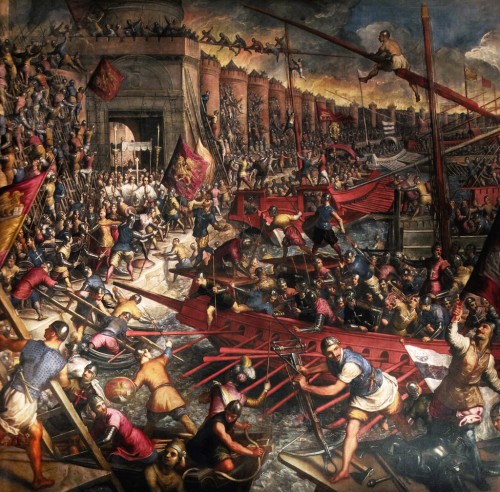
The Venetians Attack Constantinople, 1204 CE
The old regime had fallen. However, the new pair of emperors went back on the arranged deal of assistance - although they had few resources to call on in reality - and also failed to formally make the Byzantine Church subordinate to the Pope. Alexios IV may not have helped the westerners very much but his people did not trust him anyway, given the way he ascended the throne and the presence of the Crusader army still outside the walls of Constantinople. The emperor's efforts to raise taxes and a massive fire in the city caused by the Crusaders setting a mosque ablaze only added fuel to the people's discontent. It was no surprise, then, that a usurper came along, one Alexios V Doukas. An army commander and senior diplomat backed by the people, Doukas seized the throne and executed his predecessors, father and son together, in January 1204 CE.
CITIZENS WERE RAPED & MASSACRED, BUILDINGS WERE TORCHED & CHURCHES DESECRATED.
Alexios Doukas, known as Mourtzouphlos or "Bushy-Browed" attempted to put up a serious defence of his capital against unfavourable odds. For now Doge Dandolo and the Crusaders saw their golden opportunity not just to receive aid from the Byzantines but to loot the city entirely for all it was worth. Alexios ensured that the mighty Theodosian Walls were further strengthened, towers were heightened, and the initiative seized with several raids made on the Crusader camps. The Crusaders retaliated by launching an all-out attack on the morning of 9 April 1204 CE, but the Byzantines repelled it. Then, on 12 April, the Crusaders attacked the weaker sea walls of the harbour and targeted two towers in particular by lashing their ships together and ramming them repeatedly. Initially, the defenders held on, but eventually, the attackers forced their way through on both the sea side and the land side when the Franks finally battered down one of the city gates. The Crusaders were into the city and carnage followed. Citizens were raped and massacred, buildings were torched and churches desecrated. Alexios fled to Thrace, and three days of looting followed.
LOOTING THE CITY
Robert de Clari, a lesser knight of the Crusader army, wrote an interesting account of the Crusade with invaluable descriptions of Constantinople's monuments and religious relics. Another record, this time by an author closer to the leadership, was compiled by Geoffrey de Villehardouin, the Marshal of Champagne. Villehardouin wrote his Conquest of Constantinoplealmost as a defence of the Crusaders' actions, and so the work is heavily biased, portraying the Byzantines as a shifty lot who only got their comeuppance. Finally, the Byzantine historian Niketas Choniates gives a vivid eyewitness account of the destruction and looting of the city in his Historia.

Horses from the Hippodrome of Constantinople
Constantinople, in 1204 CE, had a population of around 300,000, dwarfing the 80,000 in Venice, western Europe's largest city at the time. But it was not only its size that impressed the Crusaders, its buildings, churches and palaces, the huge forums and gardens, and, above all, its riches struck awe in the western visitors. Then awe was swiftly replaced by greed. Monumental sculptures, countless artworks, books, manuscripts, and jewels which had been steadily accumulated by emperors and nobles over a millennium were all stripped away and either destroyed or melted down for coinage. Furniture, doors, and marble architectural elements were taken away for reuse elsewhere, and even the tombs of emperors, including that of the great Justinian I, were opened up and their precious contents removed.
One of the most precious of all Byzantine religious relics to be stolen was the Mandylion shroud, a cloth or scarf said to have carried an impression of Christ himself. It was taken as a prize to France but, alas, this priceless icon was destroyed during the French Revolution. In another example, a gold reliquary containing a fragment of the True Cross ended up in the cathedral of Limburg in Germany. The Hippodrome of Constantinople, especially, was looted for all the treasures which stood in the central island around which the chariots raced. The four bronze horses now in St. Mark's Cathedral in Venice were probably once part of a chariot group which stood atop the arena's monumental entrance gate.
The Byzantines lamented not only the awful bloodshed and the monetary loss of the sacking but also the destruction of historically important artworks which they knew full well connected the city and, indeed, the western world back to its Romanheritage. The world had lost something great and undefinable, as powerfully summarised here by the historian JJ Norwich:
By the sack of Constantinople, Western civilization suffered a loss greater than the burning of the library of Alexandria in the fourth century or the sack of Rome in the fifth - perhaps the most catastrophic single loss in all history. (306)
 DIVISION OF THE BYZANTINE EMPIRE, 1204 CE.
DIVISION OF THE BYZANTINE EMPIRE, 1204 CE.

AFTERMATH
The emperor Alexios V Doukas fled the city, but he was later captured, blinded, and then tossed to his death from the top of a column a few months later. After the dust settled and everyone had their fill of pillaging and looting, the Partitio Romaniaetreaty, already decided on beforehand, carved up the Byzantine Empire amongst Venice and its allies. The Venetians took three-eighths of Constantinople, the Ionian islands, Crete, Euboea, Andros, Naxos, and a few strategic points along the coast of the Sea of Marmara. Baldwin of Flanders was then made the Latin emperor (r. 1204-1205 CE) and crowned in the Hagia Sophia, receiving five-eighths of Constantinople and one-quarter of the empire which included Thrace, northwest Asia Minor, and several Aegean islands (notably Chios, Lesbos, and Samos ). Boniface of Montferrat took over Thessalonicaand formed a new kingdom there which also included Athens and Macedonia. In 1205 CE, following the death of Baldwin in a Bulgarian prison, William I Champlitte and Geoffrey I Villehardouin (nephew of the historian of the same name) founded a Latin principality in the Peloponnese while the French duke Othon de la Roche grabbed Attica and Boeotia.
The Byzantine Empire would be re-established in 1261 CE, albeit a shadow of its former self, when forces from the Empire of Nicaea, the centre of the Byzantines-in-exile (1208-1261 CE) retook Constantinople. Emperor Michael VIII (r. 1259-1282 CE) was then able to place his throne back in the palace of his Byzantine predecessors.
LICENSE:
Article based on information obtained from these sources:with permission from the Website Ancient History Encyclopedia
Content is available under License Creative Commons: Attribution-NonCommercial-ShareAlike 3.0 Unported. CC-BY-NC-SA License